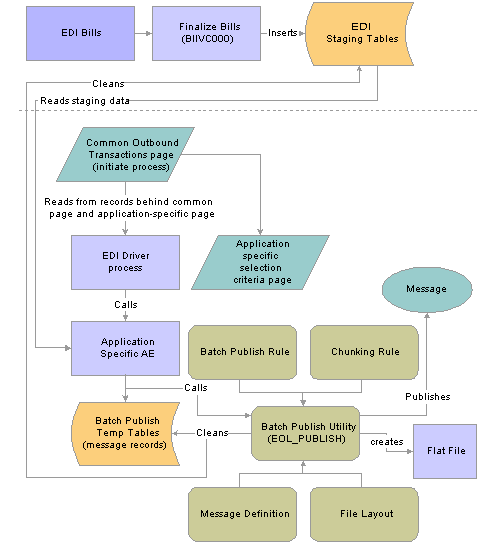 Understanding EDI Transactions
Understanding EDI TransactionsThis chapter provides an overview of electronic data interchange (EDI) transactions and discusses how to:
Process outbound transactions.
Define customers as EDI customers.
 Understanding EDI Transactions
Understanding EDI TransactionsEDI is the mechanism by which business data is transferred between a trading partner and a business application. A trading partner can be either a specific target organization, such as a vendor or a customer, or a specific application such as PeopleSoft Billing. To integrate with third-party trading partners, merchants, and other external systems more effectively, PeopleSoft includes Application Messaging as an integration tool.
Application Messaging, an architecture that uses a Publish/Subscribe model to integrate PeopleSoft applications with each other and with third-party applications, enables applications to publish data to which multiple processes can subscribe. These processes can be located on the same database and server, or on another database and server. It works in an asynchronous environment, which means that the publisher doesn’t need to be connected to the subscriber when publishing the data. This is comparable to the way email uses queues to guarantee the delivery of a message to its subscribers.
Application Messaging offers an automated, timely, and efficient way to send data across systems. Application Messaging helps synchronize data that is stored in different systems, enables system-to-system workflow, and supports business-to-business integration through the internet using XML and HTTP.
Note. You can elect to process the EDI transactions using a flat file.
See Setting Up the Billing Invoice EIP.
See Also
Getting Started with Electronic Data Interchange Messaging
 Processing the PeopleSoft Billing Invoice Notice Transaction
Processing the PeopleSoft Billing Invoice Notice TransactionPeopleSoft Billing supports a single Publish Outbound Transaction: Billing Invoice Notice. The Billing Invoice integration point meets X.12 EDI requirements of the 856 transaction set. Billing Invoice is an outbound asynchronous batch publish integration point. If enabled, the system generates a Billing Invoice integration point transaction message when you run the Finalize Bills process (BIIVC000).
Use the Publishing Outbound Messages page to initiate the outbound message process. Select from the listed outbound transactions to launch a transaction-specific process page.
The Billing Invoice Notice Process (BI_INVOUT)
The Billing Invoice Notice process (BI_INVOUT) is a PeopleSoft Billing Application Engine program that the system calls from IN_PUB_MSG when you publish an EDI bill. BI_INVOUT is an Outbound Message publish program that uses the Batch Publish method. It calls the EOL_PUBLISH library to publish XML messages containing the invoice information.
This flowchart is specific to the Billing Invoice Notice:

Billing EDI Outbound Process Flow
Note. The message records used in BI_INVOUT are vulnerable to fragmentation due to frequent deletes and inserts. Database administers should maintain the Message Definition BI_Xxxxxxx_TAO records at regular intervals. To avoid fragmentation, database administrators should drop and recreate these records during the lag time, when these tables are empty. The frequency of defragmentation required for these tables depends on the volume of data processed through this program. Depending on the database platform (Oracle/SQL Server), database administrators can also issue a TRUNCATE command on these records to ensure that this program runs more efficiently.
See Also
Managing PeopleSoft Supply Chain Management Integration Points

 Page Used to Process the Billing Invoice Notice Transaction
Page Used to Process the Billing Invoice Notice Transaction
 Defining Customers as EDI Customers
Defining Customers as EDI CustomersWhen a bill is created for an EDI customer through either the online bill entry pages or the Billing Interface, the system will set the Bill-To Media field to EDI. (The Bill-To Media default can be overridden in bill entry, but not through the Billing Interface.) To have the Bill-To Media default to EDI for a customer, you must set the customer's billing contact to use XML as the preferred method of communication for receiving invoices.
To define a customer as an EDI customer:
Access the Contact Addtl Info (contact additional information) page for the customer's billing contact.
In the Documentation section, select Invoice in the Document Code field, adding a new row, if necessary.
Select XML Only or XML & Print in the Preferred Communication field.
Note. No matter which setting is chosen for preferred communication, a bill is only transmitted through EDI when the bill-to media is set to EDI at the time the bill is finalized.
See Also
PeopleTools 8.46 PeopleBook: PeopleSoft Integration Broker